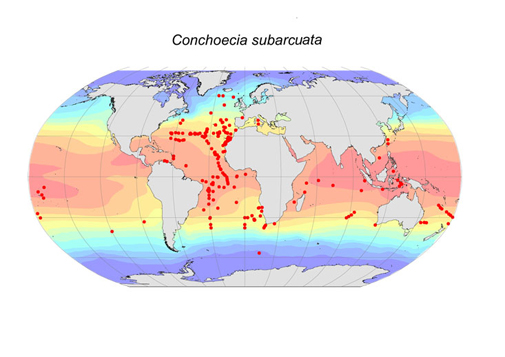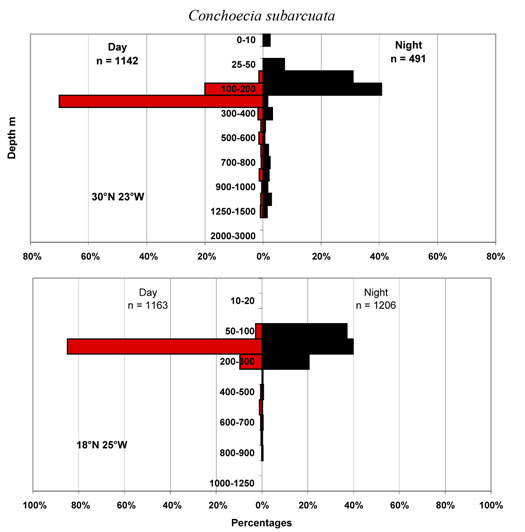Atlas of Atlantic Ostracods
Taxon details
Conchoecia subarcuata Claus, 1890
- Order:
- MYODOCOPA
- Suborder:
- Halocypridina
- Family:
- Halocyprididae
- Subfamily:
- Conchoecinae
- Size range (females):
- 1.9-2.4 mm
- Size range (males):
- 1.8-2.0 mm
- Depth:
- epi-/mesopelagic
Notes
383 records
Müller (1906) placed this species in his “magna group” and Poulsen (1973) retained in Conchoecia. The full range of its geographical range is 56°S to 60°N, but its true range is probably more restricted. For example in the Southern Hemisphere Müller (1906) reported a single specimen at 56°S, otherwise the furthest south it has been recorded is 40°S despite the extensive sampling in the Southern Ocean that has been carried out particularly from Discovery and the Eltanin. Similarly in the North Atlantic Vavra (1906) recorded it from three stations around 60°N, whereas all other records are from south of 53°N; many of Vavra’s records are dubious. Most males and juveniles are taken at depths of 100-300m by day; the main centre of the bathymetric range of females is similar, but individual specimens turn up regularly from deeper depths down to 1250m. A small proportion of adult females of several other species appear to move down into deep water in a similar fashion. At night there is a slight upward movement of all stages to 100-50m and juveniles are occasionally taken in the neuston. This species is noticeably slimmer than its congeners, and the cells of right asymmetrical gland are much larger.
Live animals are translucent and lightly pigmented yellow and orange around the bases of the limbs.
| NEA | n | Mean mm | s.d. | Range mm |
|---|---|---|---|---|
| Female | 90 | 2.12 | 0.090 | (1.82) 1.94-2.36 |
| Male | 12 | 1.90 | 0.032 | 1.84-1.96 |
| A-1 | 26 | 1.35 | 0.055 | 1.20-1.44 |
| A-2 | 17 | 0.89 | 0.034 | 0.82-0.92 |
| A-3 | 18 | 0.60 | 0.029 | 0.56-0.64 |
| All others | n | Mean mm | s.d. | Range mm |
|---|---|---|---|---|
| Female | 169 | 2.14 | 0.062 | 1.95-2.28 |
| Male | 77 | 1.91 | 0.038 | 1.70-2.00 |
| A-1 | 38 | 1.40 | 0.047 | 1.30-1.48 |





